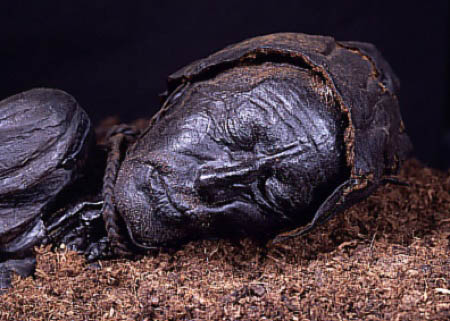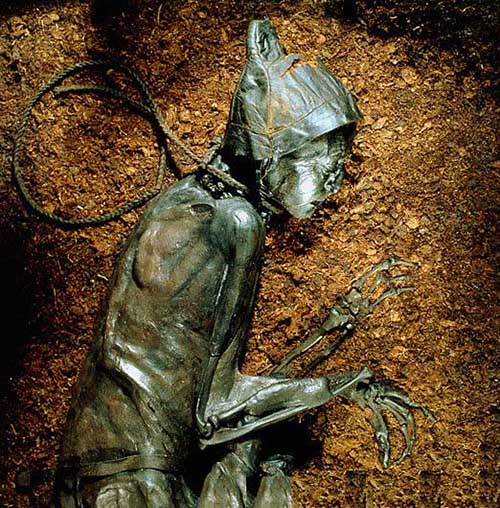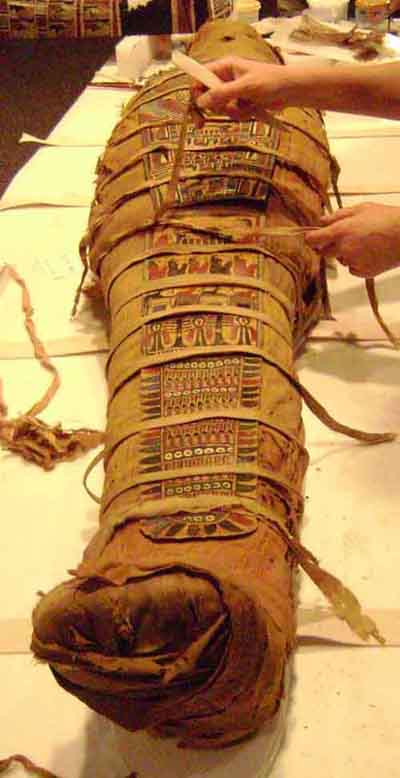

Bog bodies, which are also known as bog people, are the naturally preserved human corpses found in the sphagnum bogs in Northern Europe. Unlike most ancient human remains, bog bodies have retained their skin and internal organs due to the unusual conditions of the surrounding area. These conditions include highly acidic water, low temperature, and a lack of oxygen, combining to preserve but severely tan their skin. Despite the fact that their skin is preserved, their bones are generally not, as the acid in the peat dissolves the calcium phosphate of bone.
The German scientist Dr. Alfred Dieck catalogued the existence of over 1,850 northern European bog bodies in 1965, but many cannot be verified by documents or archaeological finds; in fact, an article in the German archaeology journal called "Archaeologisches Korrespondenzblatt" concluded that many of the cases were fabricated. Most, although not all, of these bodies have been dated to the Iron Age. Many show signs of having been killed and deposited in a similar manner, indicating some sort of ritual element, which many archaeologists believe show that these were the victims of human sacrifice in Iron Age Germanic paganism; though Cornelius Tacitus specifically describes bogging as a form of (sacralized) capital punishment in his 1st century work Germania. Some of the most notable examples of bog bodies include Tollund Man and Grauballe Man from Denmark and Lindow Man from England.

Tollund Man
A limited number of bogs have the correct conditions for preservation of mammalian tissue. Most of these are located in the colder climes of northern Europe near bodies of salt water. For example, in the area of Denmark where the Haraldsar Woman was recovered, salt air from the North Sea blows across the Jutland wetlands and provides an ideal environment for the growth of peat. As new peat replaces the old peat, the older material underneath rots and releases humic acid, also known as bog acid. The bog acids, with pH levels similar to vinegar, conserve the human bodies in the same way as fruit is preserved by pickling.
In addition, peat bogs form in areas lacking drainage and hence are characterized by almost completely anaerobic conditions. This environment, highly acidic and devoid of oxygen, denies the prevalent subsurface aerobic organisms any opportunity to initiate decomposition. Researchers discovered that conservation also required the body to be placed in the bog during the winter or early spring when the water temperature is cold - i.e., less than 4 ° C (40 ° F). This allows the bog acids to saturate the tissues before decay can begin. Bacteria are unable to grow rapidly enough for decomposition at temperatures under 4 ° C.
The bog chemistry environment involves a completely saturated acidic environment, where considerable concentrations of organic acids and aldehydes are present. Layers of sphagnum and peat assist in preserving the cadavers by enveloping the tissue in a cold immobilizing matrix, impeding water circulation and any oxygenation. An additional feature of anaerobic preservation by acidic bogs is the ability to conserve hair, clothing and leather items.
Modern experimenters have been able to mimic bog conditions in the laboratory and successfully demonstrate the preservation process, albeit over shorter time frames than the 2,500 years that Haraldskūr Woman's body has survived. Most of the bog bodies discovered had some aspects of decay or else were not properly conserved. When such specimens are exposed to the normal atmosphere, they may rapidly begin to decompose. As a result, many specimens have been effectively destroyed, such as the first bog body from Husbake. It is estimated that 53 bog bodies (the Cashel Man being the latest discovered) have survived.
The vast majority of the bog bodies that have been discovered date from the Iron Age, a period of time when the peat bogs covered a much larger area of northern Europe than they do currently. Many of these Iron Age bodies bear a number of similarities, indicating a known cultural tradition of killing and depositing these people in a certain manner. These Pre-Roman Iron Age peoples lived in sedentary communities, who had built villages, and whose society was hierarchical. They were agriculturalists, raising animals in captivity as well as growing crops. In some parts of northern Europe, they also hunted fish. Although independent of the Roman Empire, which dominated southern Europe at this time, the Bog People traded with the Romans.
For these people, the bogs held some sort of significance, and indeed, they placed votive offerings into them, often of neck-rings, wristlets or ankle-rings made of bronze or more rarely gold. The archaeologist P.V. Glob believed that these were "offerings to the gods of fertility and good fortune", a viewpoint that is widely supported. It is therefore widely speculated that the Iron Age bog bodies were thrown into the bog for similar reasons, and that they were therefore examples of human sacrifice to the gods. Nonetheless, others speculate, based on clear reference to the practice in Tacitus' Iron Age work, Germania, that the bog bodies were criminals who were executed before being deposited in the bog rather than religious sacrifices.
Many bog bodies show signs of being stabbed, bludgeoned, hanged or strangled, or a combination of these methods. In some cases the individual had been beheaded, and in the case of the Osterby Head found at Kohlmoor, near to Osterby, Germany in 1948, the head had been deposited in the bog without its body.
Usually the corpses were naked, sometimes with some items of clothing with them, particularly headgear. In a number of cases, twigs, sticks or stones were placed on top of the body, sometimes in a cross formation, and at other times forked sticks had been driven into the peat to hold the corpse down. According to the archaeologist P.V. Glob, "this probably indicates the wish to pin the dead man firmly into the bog." Some bodies show signs of torture, such as Old Croghan Man, who had deep cuts beneath his nipples.
Some bog bodies, such as Tollund Man from Denmark, have been found with the rope used to strangle them still around their necks. Some, such as the Yde Girl in the Netherlands and bog bodies in Ireland, had the hair on one side of their heads closely cropped, although this could be due to one side of their head being exposed to oxygen for a longer period of time than the other. Some of the bog bodies seem consistently to have been members of the upper class: their fingernails are manicured, and tests on hair protein routinely record good nutrition. Strabo records that the Celts practiced auguries on the entrails of human victims: on some bog bodies, such as one of the Weerdinge Men found in southern Netherlands, the entrails have been partly drawn out through incisions.
Modern techniques of forensic analysis now suggest that some injuries, such as broken bones and crushed skulls, were not the result of torture, but rather due to the weight of the bog. For example, the fractured skull of Grauballe Man was at one time thought to have been caused by a blow to the head. However, a CT scan of Grauballe Man by Danish scientists determined his skull was fractured due to pressure from the bog long after his death.
There are bog bodies that are exceptions in that they do not date to the Iron Age. The oldest known bog body is that of the Koelbjerg Woman who was found in Denmark, and has been dated to around 8000 BCE during the Stone Age. Amongst the most recent, the corpse of Meenybradden Woman found in Ireland dates to the 16th century AD and was found in unhallowed ground, with evidence indicating that she may have committed suicide and was therefore buried in the bog rather than in the churchyard because she had committed a Christian sin. She may have also been unable to afford proper burial. Bog bodies have also formed from the corpses of Russian and German soldiers killed fighting on the Eastern Front during the First World War in the Masurian Lake District region of north-eastern Poland.
A number of skeletons found in Florida have been called "bog people". These skeletons are the remains of people buried in peat between 5,000 and 8,000 years ago, during the Early and Middle Archaic period in the Americas. The peat at the Florida sites is loosely consolidated, and much wetter than in European bogs. As a result, the skeletons are well preserved, but skin and most internal organs have not been preserved. An exception is that preserved brains have been found in a nearly 100 skulls at Windover Archaeological Site and in one skull at Little Salt Spring. Textiles were also preserved with some of the burials, the oldest known textiles in Florida.
Ever since the Iron Age, humans have used the bogs to harvest peat, a common fuel source. On various occasions throughout history, peat diggers have come across bog bodies. Records of such finds go back as far as the 17th century, and in 1640 a bog body was discovered at Shalkholz Fen in Holstein, Germany. This was possibly the first ever such discovery to be recorded. The first more fully documented account of discovery of a bog body was at a peat bog on Drumkeragh Mountain in County Down, Ireland; it was published by Elizabeth Rawdon, Countess of Moira, the wife of the local landowner.
Such reports continued into the 18th century: for instance, a body was reportedly found on the Danish island of Fyn in 1773, whilst the Kibbelgaarn body was discovered in the Netherlands in 1791. Throughout the 18th and 19th centuries, when such bodies were discovered, they were often removed from the bogs and given a Christian burial on consecrated church ground in keeping with the religious beliefs of the community who found them, who often assumed them to be relatively modern.
With the rise of antiquarianism in the 19th century, some people began to speculate that many of the bog bodies were not recent murder victims but were ancient in origin. In 1843, at Corselitze on Falster in Denmark, a bog body unusually buried with ornaments (seven glass beads and a bronze pin) was unearthed and subsequently given a Christian burial. By order of the Crown Prince Frederick, who was an antiquarian, the body was dug up again and sent to the National Museum of Denmark. According to the archaeologist P.V. Glob, it was "he, more than anyone else, helped to arouse the wide interest in Danish antiquities" such as the bog bodies.
After the Haraldskūr Woman was unearthed in Denmark, she was exhibited as having been the legendary Queen Gunhild of the early Mediaeval period. This view was disputed by the archaeologist J. J. A. Worsaae, who argued that the body was Iron Age in origin, like most bog bodies, and predated any historical persons by at least 500 years. The first bog body to be photographed was the Iron Age Rendswhren Man, discovered in 1871, at the Heidmoor Fen, near Kiel in Germany. His body was subsequently smoked as an early attempt at conservation and put on display in a museum.
With the rise of modern archaeology in the early 20th Century, the bog bodies began to be excavated and investigated more carefully and thoroughly.
Until the mid-20th century, it was not readily apparent at the time of discovery whether a body has been buried in a bog for years, decades, or centuries. But, modern forensic and medical technologies (such as radiocarbon dating) have been developed that allow researchers to more closely determine the age of the burial, the person's age at death, and other details. Scientists have been able to study the skin of the bog bodies, reconstruct their appearance and even determine what their last meal was from their stomach contents. Their teeth also indicate their age at death and what type of food they ate throughout their lifetime. Subsurface radar can be used by archaeologists to detect bodies and artifacts beneath the bog surface before cutting into the peat. Radio carbon dating is also common as it accurately gives the date of the find, most usually from the Iron Age.
Because the peat marsh preserves soft internal tissue, the stomach contents can be analyzed. These give a good picture of the diet of those people. Forensic facial reconstruction is one particularly impressive technique used in studying the bog bodies. Originally designed for identifying modern faces in crimes, this technique is a way of working out the facial features of a person by the shape of their skull. The face of one bog body, Yde Girl, was reconstructed in 1992 by Richard Neave of Manchester University using CT scans of her head. Yde Girl and her modern reconstruction are displayed at the Drents Museum in Assen. Such reconstructions have also been made of the heads of Lindow Man (British Museum, London, United Kingdom), Grauballe Man, Girl of the Uchter Moor, Clonycavan Man, Roter Franz and Windeby I.

EuropeÕs Famed Bog Bodies Are Starting to Reveal Their Secrets Smithsonian - May 8, 2020
High-tech tools divulge new information about the mysterious and violent fates met by these corpses
Clonycavan Man: A 2,300-Year-Old Murder Mystery Epoch Times - October 28, 2014
In March 2003, the body of a man who lived during the Iron Age was discovered in a peat bog in Ireland. Known as the Clonycavan Man, the well-preserved remains indicate that the body was not that of a man who died a natural or honorable death, but one who was brutally murdered. The mysteries surrounding his death are plentiful. Who was this man? Why was he so brutally murdered? How was his body so well preserved for so many years? And what is the significance of his highly groomed hair?
Oldest 'Bog Body' Found with Skin Intact Live Science - August 20, 2013
Archaeologists have unearthed the remains of a 4,000-year-old man preserved in an Irish peat bog, marking the oldest European body ever found with skin still intact. The cool, waterlogged conditions of Northern European bogs (a type of wetland) create low-oxygen, highly acidic environments ideal for body preservation. As a result, hundreds of "bog bodies" dating back thousands of years have been uncovered in the region, but many have shriveled down to mostly skeletons and tend to be closer to 2,000 years old.
A resident of central Ireland's County Laois came across the well-preserved "Cashel Man" - named for the bog he was found in - while milling for peat moss, which is used for a variety of farm purposes, including animal-bedding and field conditioning.
Remains of Hundreds of Ancient Warriors Found in Bog Live Science - August 14, 2012
For almost two months so far, excavators in Denmark have been uncovering the remains of hundreds of warriors who died violently about 2,000 years ago. The evidence of violence is clear at the site, which is now a bog. Excavators reported today (Aug. 14) that they have uncovered damaged human bones, including a fractured skull and a thigh bone that was hacked in half, along with axes, spears, clubs and shields. Over the years, human bones have turned up periodically in the area. This summer's excavation follows on work done in 2008 and 2009, when archaeologists found single, scattered bones lying under about 6.6 feet (2 meters) of peat on an old lake bed in the Alken Enge wetlands near Lake Mossŋ in East Jutland, Denmark.
Bog Mummies Yield Secrets Science Daily - September 10, 2007
Human remains yield secrets. Researchers, including Dr. Heather Gill-Robinson, assistant professor of anthropology at North Dakota State University, are now probing the secrets of 'bog mummies' some dating back 2000 years, preserved from the Iron Age with amazing detail in peat bogs of Europe. Bog mummies have particularly interesting stories to tell. Physical anthropologists draw conclusions from the eerily preserved hair, leathery skin and other features that emerge from the bogs.
During the Iron Age from approximately 500BC to 500AD, bodies were often cremated, often leading experts to believe that mummies uniquely preserved by the bogs were people who met their demise through particularly violent means or were used as sacrifices, although there are numerous possible other explanations. A violent demise was thought to be the case for a mummy known as Windeby Girl, studied by Dr. Gill-Robinson. Discovered in northern Germany in 1952, experts thought she may have been an adulteress whose head was shaved, after which she was blindfolded and drowned in the bog.
Hundreds of bog bodies have been recovered and studied. The bodies have been most commonly found in the Northern European countries of Denmark, Germany, The Netherlands, United Kingdom and Ireland. In 1965, the German scientist Alfred Dieck cataloged more than 1,850 bog bodies, but later scholarship revealed much of the Dieck's work was erroneous, and an exact number of discovered bodies is unknown.
Several bog bodies are notable for the high quality of their preservation and the substantial research by archaeologists and forensic scientists. These include:
Borremose Bodies, from 400-700 BCE, found in the 1940s in Himmerland, Denmark.
Cladh Hallan, Scotland mummies, from 1600-1300 BCE, found on the island of South Uist, Scotland.
Clonycavan Man, from 392-201 BCE, found in 2003 in County Meath, Ireland
Girl of the Uchter Moor, found in 2000 in Uchte, Germany.
Grauballe Man, from 290 BCE, found in 1952 in Jutland, Denmark.
Haraldsaer Woman, from 490 BCE, found in 1835 in Jutland, Denmark.
Lindow Man, from 2 BCE - 119 CE, found in 1984 in Cheshire, England.
Old Croghan Man, from 362-175 BCE, found in 2003 County Offaly, Ireland.
Tollund Man, from 400 BCE, found in 1950 in Jutland, Denmark.
Weerdinge Men, from 160-220 BCE, found in Drenthe, Netherlands in 1904.
Windeby I, found in 1952 in Schleswig-Holstein, Germany.
Yde Girl, 170 BCE-230 CE, found in 1897 near Yde, Netherlands.

Mummies
ANCIENT AND LOST CIVILIZATIONS